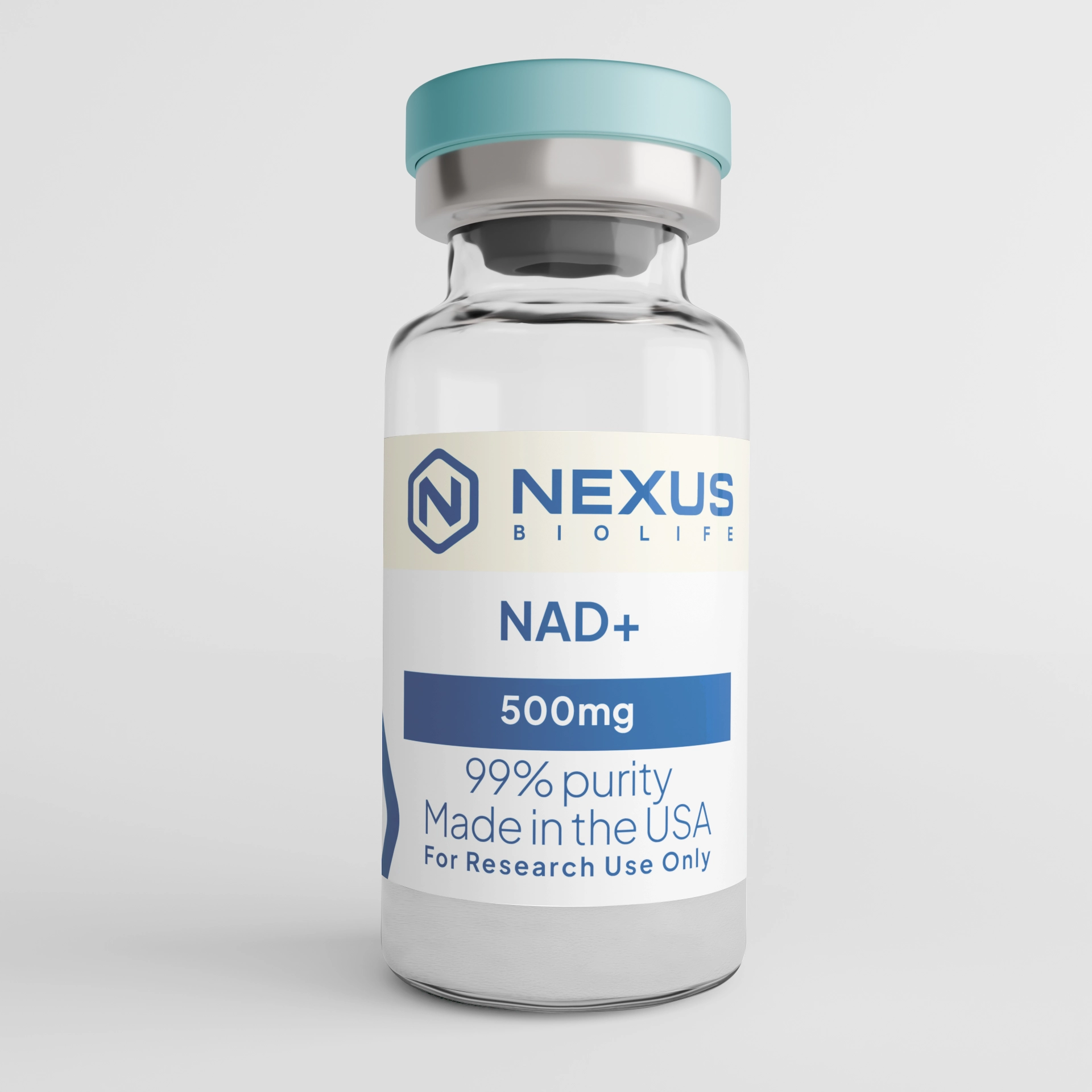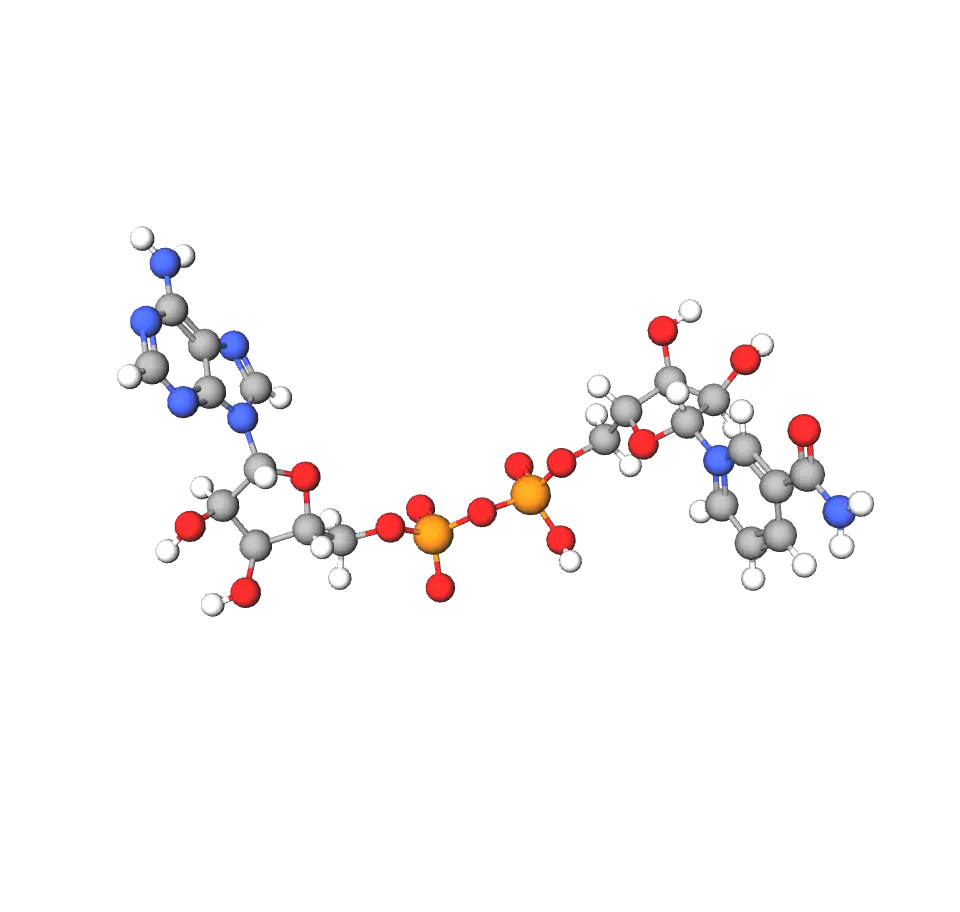
NAD+ compounds are specialized coenzymes produced for laboratory applications. With guaranteed high purity, these products are engineered for consistent results in scientific environments. Researchers utilize these preparations in controlled studies. NAD+ is designated exclusively for research and development.

NAD+ consists of two nucleotides joined by a pyrophosphate linkage: one containing nicotinamide and ribose (nicotinamide mononucleotide, NMN), and the other with adenine and ribose (adenosine monophosphate, AMP), resulting in the molecular formula C21H27N7O14P2 and a molecular weight of approximately 663.4 g/mol. It exists in oxidized (NAD+) and reduced (NADH) forms, with the nicotinamide ring accepting or donating hydride ions during redox reactions. This structure enables its role as a cofactor, and its biosynthesis occurs via pathways like the de novo route from tryptophan or salvage from precursors such as nicotinamide or nicotinic acid.
In lab environments, NAD+ is often provided as a white to off-white powder with high solubility in water (up to 50 mg/mL), though it is sensitive to light, heat, and pH extremes, which can lead to hydrolysis. Our batches undergo rigorous purity testing, typically exceeding 98% via HPLC, ensuring reliability for your experiments. We''re transparent about these details, so you can approach your work with confidence in the product''s consistency.
Nicotinamide adenine dinucleotide (NAD+) is a vital coenzyme found in all living cells, serving as a key player in redox reactions and energy metabolism while also acting as a substrate for various enzymes involved in cellular signaling and repair. Composed of two linked nucleotides, NAD+ facilitates the transfer of electrons in metabolic pathways and supports processes like DNA maintenance and stress responses, making it an essential tool for in-vitro research into aging, metabolic disorders, and cellular homeostasis. Remember, our NAD+ is supplied strictly for research purposes and in-vitro use only—not for human consumption or any diagnostic or therapeutic applications.
NAD+ acts primarily as a coenzyme in over 500 enzymatic reactions, shuttling electrons in metabolic pathways such as glycolysis, the citric acid cycle, and oxidative phosphorylation, where it is reduced to NADH to support ATP production. Beyond redox functions, NAD+ serves as a substrate for enzymes like sirtuins (which deacetylate proteins to regulate gene expression and longevity), poly(ADP-ribose) polymerases (PARPs, involved in DNA repair and inflammation), and CD38/CD157 (which generate signaling molecules like cyclic ADP-ribose). Declining NAD+ levels with age disrupt these processes, leading to mitochondrial dysfunction and increased oxidative stress, which MOTS-c-like interventions aim to counteract.
In cellular models, boosting NAD+ activates AMPK and PGC-1α pathways, enhancing mitochondrial biogenesis and fatty acid oxidation while inhibiting NF-κB to reduce inflammation. This multifaceted role highlights NAD+ as a central regulator of energy homeostasis and cellular resilience—we''re always ready to chat about how it fits into your specific assays, breaking down the science in a straightforward way.
In summary, NAD+ stands as an indispensable coenzyme for unraveling the intricacies of cellular energy, repair, and adaptation, offering researchers a foundational element to probe metabolic and age-related mechanisms in controlled environments. Its broad implications in health and disease drive our enthusiasm for providing top-quality tools that empower informed science with transparency. Exclusively for in-vitro research, NAD+ exemplifies our approachable commitment to fostering collaborative progress. Let''s connect to refine your investigations, one insightful step at a time.
NAD+''s involvement in core cellular processes makes it a cornerstone for in-vitro research across metabolism, aging, and disease modeling. In cell culture studies, it has been used to investigate mitochondrial function in cardiac models, where supplementation restores NAD+ levels to mitigate age-related decline and improve energy production in cardiomyocytes. Applications in neurodegenerative models explore its role in DNA repair via PARPs, showing potential to alleviate oxidative damage in neuronal cells.
Researchers also employ NAD+ in metabolic disorder assays, such as those simulating type 2 diabetes, where it enhances insulin sensitivity and glucose uptake through sirtuin activation. In inflammation-focused work, NAD+ modulation reduces cytokine production in immune cell lines, providing insights into sepsis or autoimmune responses. Emerging uses include bone health studies, where it supports osteoblast activity, and cancer models examining its dual role in tumor metabolism. We love supporting these explorations with practical advice, like optimizing concentrations for your cell types to yield clear, actionable data.
To maintain NAD+''s stability in your in-vitro setups, store the powder at -20°C in a dry, light-protected container, as exposure to moisture or UV can accelerate degradation. For reconstitution, use sterile water or a neutral buffer to achieve concentrations of 1-10 mM, gently mixing to avoid foaming that might introduce oxygen and promote oxidation. Reconstituted solutions should be aliquoted and used fresh, with short-term storage at 4°C or freezing for longer periods, but minimize freeze-thaw cycles to preserve activity.
Our testing includes stability assessments under various conditions, ensuring it meets high standards. If you encounter any handling quirks, our team offers calm, logical solutions based on evidence—feel free to reach out.
Nicotinamide adenine dinucleotide (NAD+) is a vital coenzyme found in all living cells, serving as a key player in redox reactions and energy metabolism while also acting as a substrate for various enzymes involved in cellular signaling and repair. Composed of two linked nucleotides, NAD+ facilitates the transfer of electrons in metabolic pathways and supports processes like DNA maintenance and stress responses, making it an essential tool for in-vitro research into aging, metabolic disorders, and cellular homeostasis. Remember, our NAD+ is supplied strictly for research purposes and in-vitro use only—not for human consumption or any diagnostic or therapeutic applications.
NAD+ acts primarily as a coenzyme in over 500 enzymatic reactions, shuttling electrons in metabolic pathways such as glycolysis, the citric acid cycle, and oxidative phosphorylation, where it is reduced to NADH to support ATP production. Beyond redox functions, NAD+ serves as a substrate for enzymes like sirtuins (which deacetylate proteins to regulate gene expression and longevity), poly(ADP-ribose) polymerases (PARPs, involved in DNA repair and inflammation), and CD38/CD157 (which generate signaling molecules like cyclic ADP-ribose). Declining NAD+ levels with age disrupt these processes, leading to mitochondrial dysfunction and increased oxidative stress, which MOTS-c-like interventions aim to counteract.
In cellular models, boosting NAD+ activates AMPK and PGC-1α pathways, enhancing mitochondrial biogenesis and fatty acid oxidation while inhibiting NF-κB to reduce inflammation. This multifaceted role highlights NAD+ as a central regulator of energy homeostasis and cellular resilience—we''re always ready to chat about how it fits into your specific assays, breaking down the science in a straightforward way.
In summary, NAD+ stands as an indispensable coenzyme for unraveling the intricacies of cellular energy, repair, and adaptation, offering researchers a foundational element to probe metabolic and age-related mechanisms in controlled environments. Its broad implications in health and disease drive our enthusiasm for providing top-quality tools that empower informed science with transparency. Exclusively for in-vitro research, NAD+ exemplifies our approachable commitment to fostering collaborative progress. Let''s connect to refine your investigations, one insightful step at a time.
NAD+ consists of two nucleotides joined by a pyrophosphate linkage: one containing nicotinamide and ribose (nicotinamide mononucleotide, NMN), and the other with adenine and ribose (adenosine monophosphate, AMP), resulting in the molecular formula C21H27N7O14P2 and a molecular weight of approximately 663.4 g/mol. It exists in oxidized (NAD+) and reduced (NADH) forms, with the nicotinamide ring accepting or donating hydride ions during redox reactions. This structure enables its role as a cofactor, and its biosynthesis occurs via pathways like the de novo route from tryptophan or salvage from precursors such as nicotinamide or nicotinic acid.
In lab environments, NAD+ is often provided as a white to off-white powder with high solubility in water (up to 50 mg/mL), though it is sensitive to light, heat, and pH extremes, which can lead to hydrolysis. Our batches undergo rigorous purity testing, typically exceeding 98% via HPLC, ensuring reliability for your experiments. We''re transparent about these details, so you can approach your work with confidence in the product''s consistency.

NAD+''s involvement in core cellular processes makes it a cornerstone for in-vitro research across metabolism, aging, and disease modeling. In cell culture studies, it has been used to investigate mitochondrial function in cardiac models, where supplementation restores NAD+ levels to mitigate age-related decline and improve energy production in cardiomyocytes. Applications in neurodegenerative models explore its role in DNA repair via PARPs, showing potential to alleviate oxidative damage in neuronal cells.
Researchers also employ NAD+ in metabolic disorder assays, such as those simulating type 2 diabetes, where it enhances insulin sensitivity and glucose uptake through sirtuin activation. In inflammation-focused work, NAD+ modulation reduces cytokine production in immune cell lines, providing insights into sepsis or autoimmune responses. Emerging uses include bone health studies, where it supports osteoblast activity, and cancer models examining its dual role in tumor metabolism. We love supporting these explorations with practical advice, like optimizing concentrations for your cell types to yield clear, actionable data.
To maintain NAD+''s stability in your in-vitro setups, store the powder at -20°C in a dry, light-protected container, as exposure to moisture or UV can accelerate degradation. For reconstitution, use sterile water or a neutral buffer to achieve concentrations of 1-10 mM, gently mixing to avoid foaming that might introduce oxygen and promote oxidation. Reconstituted solutions should be aliquoted and used fresh, with short-term storage at 4°C or freezing for longer periods, but minimize freeze-thaw cycles to preserve activity.
Our testing includes stability assessments under various conditions, ensuring it meets high standards. If you encounter any handling quirks, our team offers calm, logical solutions based on evidence—feel free to reach out.
